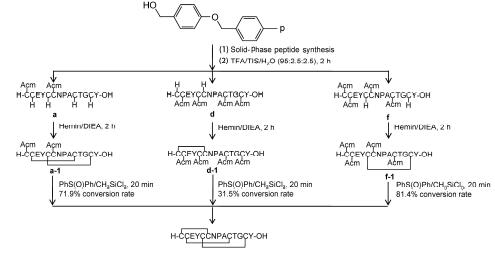| [1] Cambridge, M. A. US 7304036, 2007.
[2] Harris, L. A.; Crowell, D. Curr. Opin. Mol. Ther. 2007, 9, 403.
[3] Andresen, V.; Camilleri, M. Drugs Future 2008, 33, 570.
[4] Wu Q. L.; Liu Z. G.; Fu C.; Lin Y. B.; Dai Q. Y. Chin. J. Org. Chem. 2010, 30, 1517(in Chinese). (吴巧玲, 刘珠果, 付超, 林原斌, 戴秋云, 有机化学, 2010, 30, 1517.)
[5] Eliasen, R.; Andresen, T. L.; Conde-Frieboes, K. W. Peptides 2012, 34, 144.
[6] Dekan, Z.; Mobli, M.; Pennington, M. W.; Fung, E.; Nemeth, E.; Alewood, P. F. Angew. Chem., Int. Ed. 2014, 53, 1.
[7] Veber, D. F.; Milkowski, J. D.; Varga, S. L.; Denkewalter, R. G.; Hirschmann, R. J. Am. Chem. Soc. 1972, 94, 5456.
[8] Munson, M. C.; Barany, G. J. Am. Chem. Soc. 1993, 115, 10203.
[9] Kawakami, T.; Aimoto, S. Tetrahedron Lett. 1998, 39, 7901.
[10] Hunter, M. J.; Komives, E. A. Anal. Biochem. 1995, 228, 173.
[11] Miriam, G. B.; Judit, T. P.; Marta, P. B.; Marta, P. B.; Oleg, W.;Matthieu, G.; Fernando, A. Biopolymers 2011, 96, 69.
[12] Ge, W. W.; Chen, J.; Zong, L.; Li, J.; Sui, S. H.; Wu, W. H.; Zhang, M.; Dong, J. J. Chem. J. Chin. Univ. 2017, 38, 1052(in Chinese). (葛巍巍, 陈静, 宗良, 李建, 隋少卉, 吴为辉, 张鸣, 董俊军, 高等学校化学学报, 2017, 38, 1052.)
[13] Akaji, K.; Tatsumi, T.; Yoshida, M.; Kimura, T.; Fujiwara, Y.; Kiso, Y. J. Am. Chem. Soc. 1992, 114, 4137.
[14] Ildikó, S.; Gitta, S.; Ference, H.; Gábor, M. Biopolymers 2006, 88, 20.
[15] Ge, W. W.; Chen, J.; Zhang, Y.; Zong, L.; Zhang, M.; Dong, J. J. J. Int. Pharm. Res. 2017, 44, 585(in Chinese). (葛巍巍, 陈静, 张也, 宗良, 张鸣, 董俊军, 国际药学研究杂志, 2017, 44, 585.) |
